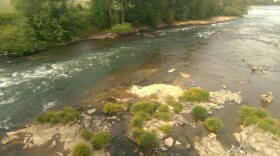
Eugene Springfield Fire has two new, state-of-the-art engines that’ll be put into action by month’s end.
The new engines will serve Fire Stations 6 and 11. Costing $2. 3 million, both were designed in consultation with the fire department, the City of Eugene’s fleet service, and manufacturer, Pierce.
Eugene Springfield Fire’s Deputy Chief of Operations, Scott Bishop, told KLCC that their design is meant to help reduce the likelihood of injuries.
”A lot of emergency incidents occur after dark with little or no lighting,” explained Bishop. “That’s one of the places that firefighters get into a very dangerous scenario, because you simply can’t see downed power lines, sagging roofs, trying to read and interpret building construction when the building is compromised by fire or structural damage.”
Bishop says the amount of illumination produced by these new vehicles are “second to none.”
The engines also have lightweight, high-strength steel ladders that can extend 107 feet.
“What most people think of when they think of length, or height, or reach of an aerial apparatus, is how tall it can go,” said Bishop. “I would stress that it’s also important how far out horizontally they could go. Setbacks of buildings, soft ground, obstructions such as other buildings in front or vehicles, impact where we’re able to position our apparatus, the chassis, on an emergency scene.
“So, by having longer horizontal reach it allows us to reach from a further distance, so that is equally important.”

The new engines will replace two others at Eugene Springfield Fire that have been in use since 2006. Bishop expects them to be in service for 15 to 20 years.
©2022, KLCC.






